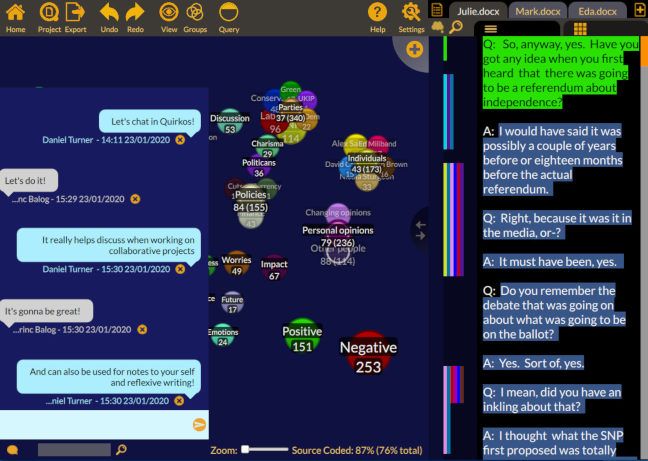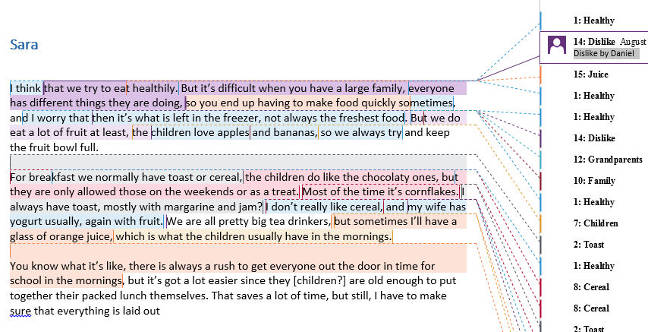How Quirkos can change the way you look at your qualitative data
We always get a lot of inquiries in December from departments and projects who are thinking of spending some left-over money at the end of the financial year on a few Quirkos licences. A great early Christmas present for yourself the team! It’s also a good long term investment

We always get a lot of inquiries in December from departments and projects who are thinking of spending some left-over money at the end of the financial year on a few Quirkos licences. A great early Christmas present for yourself and the team! It’s also a good long term investment, since our licences don’t expire and can be used year after year. They are transferable to new computers, and we’ve committed to provide free updates for the current version. We don’t want the situation where different teams are using different versions, and so can’t share projects and data. Our licences are often a fraction of the cost of other qualitative software packages, but for the above reasons we think that we offer much more value than just the comparative sticker price.
But since Quirkos also has a different ethos (accessibility) and some unique features, it also helps you approach your qualitative research data in a different way to other software. In the two short years that Quirkos has been available, it’s become used by more than 100 universities across the world, as well as market research firms and public sector organisations. That has given me a lot of feedback that helps us improve the software, but also a sense of what things people love the most about it. So following is the list of things I hear most about the software in workshops and e-mails.
It’s much more visual and colourful

Experienced researchers who have used other software are immediately struck by how colourful and visual the Quirkos approach is. The interface shows growing bubbles that dynamically show the coding in each theme (or node), and colours all over the screen. For many, the Quirkos design allows people to think in colours, spatially, and in layers, improving the amount of information they can digest and work with. Since the whole screen is a live window into the data, there is less need to generate separate reports, and coding and reviewing is a constant (and addictive) feedback process.
This doesn’t appeal to everyone, so we still have a more traditional ‘tree’ list structure for the themes which users can switch between at any time.
I can get started with my project quicker
We designed Quirkos so it could be learnt in 20 minutes for use in participatory analysis, so the learning curve is much lower than other qualitative software. Some packages can be intimidating to the first-time user, and often have 2 day training courses. All the training and support materials for Quirkos are available for free on our website, without registration. We increasingly hear that students want self-taught options, which we provide in many different formats. This means that not only can you start using Quirkos quickly, setting up and putting data into a new project is a lot quicker as well, making Quirkos useful for smaller qualitative projects which might just have a few sources.
I’m kept closer to my data

It’s not just the live growing bubbles that mean researchers can see themes evolve in their analysis, there are a suite of visualisations that let you quickly explore and play with the data. The cluster views generate instant Venn diagrams of connection and co-occurrences between themes, and the query views show side-by-side comparisons for any groups of your data you want to compare and contrast. Our mantra has been to make sure that no output is more than one click away, and this keeps users close to their data, not hidden away behind long lists and sub-menus.
It’s easier to share with others

Quirkos provides some unique options that make showing your coded qualitative data to other people easier and more accessible. The favourite feature is the Word export, which creates a standard Word document of your coded transcripts, with all the coding shown as colour coded comments and highlights. Anyone with a word processor can see the complete annotated data, and print it out to read away from the computer.
If you need a detailed summary, the reports can be created as an interactive webpage, or a PDF which anyone can open. For advanced users you can also export your data as a standard spreadsheet CSV file, or get deep into the standard SQLite database using any tool (such as https://sqlitebrowser.org/) or even a browser extension.
I couldn’t get to grips with other qualitative software

It is very common for researchers to come along to our workshops having been to training for other qualitative analysis software, and saying they just ‘didn’t get it’ before. While very powerful, other tools can be intimidating, and unless you are using them on a regular basis, difficult to remember all the operations. We love how people can just come back to Quirkos after 6 months and get going again.
We also see a lot of people who tried other specialist qualitative software and found it didn’t fit for them. A lot of researchers go back to paper and highlighters, or even use Word or Excel, but get excited by how intuitive Quirkos makes the analysis process.
Just the basics, but everything you need
I always try and be honest in my workshops and list the limitations of Quirkos. It can’t work with multimedia data, can’t provide quantitative statistical analysis, and has limited memo functionality at the moment. But I am always surprised at how the benefits outweigh the limitations for most people: a huge majority of qualitative researchers only work with text data, and share my belief that if quantitative statistics are needed, they should be done in dedicated software. The idea has always been to focus on making the core actions that researchers do all the time (coding, searching, developing frameworks and exploring data) and make them as smooth and quick as possible.
If you have comments of your own, good or bad, we love to hear them, it’s what keeps us focused on the diverse needs of qualitative researchers.
Get in touch and we can help explain the different licence options, including ‘seat’ based licences for departments or teams, as well as the static licences which can be purchased immediately through our website. There are also discounts for buying more than 3 licences, for different sectors, and developing countries.
Of course, we can also provide formal quotes, invoices and respond to purchase orders as your institution requires. We know that some departments take time to get things through finances, and so we can always provide extensions to the trial until the orders come through – we never want to see researchers unable to get at their data and continue their research!
So if you are thinking about buying a licence for Quirkos, you can download the full version to try for free for one month, and ask us any questions by email (sales@quirkos.com) or a good old 9-to-5 phone call on (+44) 0131 555 3736. We are here for qualitative researchers of all (coding) stripes and spots (bubbles)!
